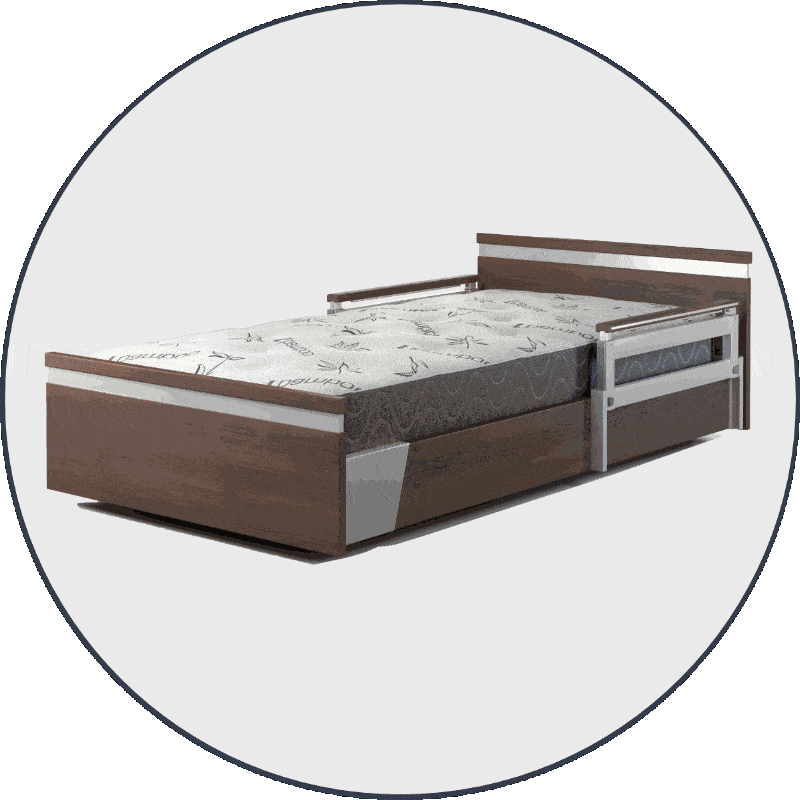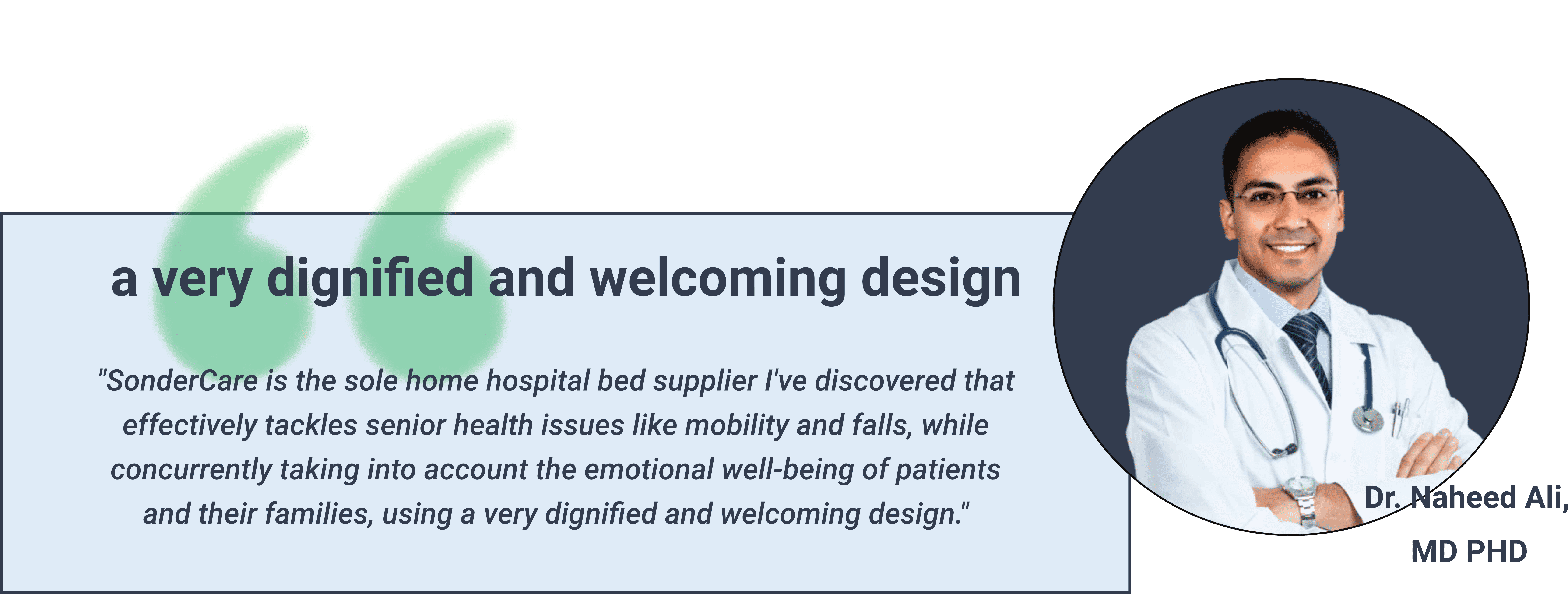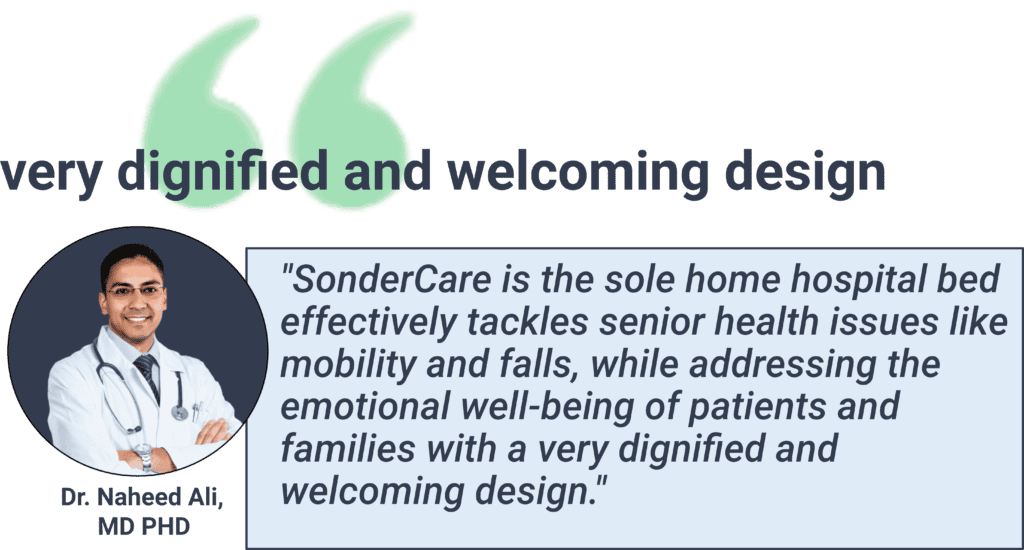Managing Myasthenia Gravis: How the Right Home Hospital Bed May Enhance Comfort, Safety, and Independence
Beyond a Place to Sleep — Your Bed as a Sanctuary for MG Management
Living with Myasthenia Gravis (MG) often means managing unpredictable muscle weakness and profound fatigue that can change from hour to hour. Tasks that once felt automatic — getting out of bed, breathing comfortably while lying down, or repositioning during the night — can become a source of anxiety and exhaustion for individuals and their caregivers.
Because so much of daily life happens in and around the bed, it can be more than furniture: it’s a central environment for rest, symptom management, and moments of independence. The right home care bed for MG can help turn that space into a sanctuary that supports breathing, is designed to reduce fall risk, helps conserve energy, and preserves dignity — all while looking and feeling like a part of your home.
SonderCare’s approach blends medical-grade functionality with residential style. These beds feature thoughtful positioning, safety engineering, whisper-quiet motors, and furniture-grade finishes that are designed to work together to support individuals with MG and the people who care for them.
An Adjustable Bed for Myasthenia Gravis to Enhance Breathing & Sleep
Respiratory muscle weakness can be a serious concern in MG, often making it difficult to breathe when lying flat. Bulbar weakness may also increase the risk of aspiration or nighttime breathing issues. According to some studies, about 20% of stable MG patients may require home non-invasive ventilation (NIV) to support breathing.[1] This suggests that an adjustable bed for Myasthenia Gravis with precise elevation controls can be a valuable tool.
Real-world respiratory challenges for those with MG can include:
- Feeling breathless when lying flat.
- Trouble finding and maintaining a comfortable position for NIV masks.
- Anxiety about reflux or aspiration while sleeping.
How a SonderCare MG breathing support bed is designed to help:
- One-touch head and upper-body elevation allows for precise adjustments to find a more comfortable bed position for breathing problems.
- Therapeutic positions like Comfort Chair and Auto‑Contour create stable, upright postures that may ease respiratory effort.
- Ultra-quiet motors enable frequent, discreet adjustments, potentially without disturbing sleep.
Potential benefits for safe home care for MG:
- Easier breathing: Elevating the head of the bed (commonly 30° or more) may help reduce the load on the diaphragm and use gravity to assist lung expansion.[2]
- Better NIV compatibility: A stable, adjustable position can make wearing NIV masks more comfortable throughout the night.[2]
- Reduced aspiration risk: An upright position may assist in managing bulbar weakness at home by helping to mitigate reflux and supporting safer swallowing.[3]
Restore Mobility and Conserve Energy with a Myasthenia Gravis Hospital Bed
Profound fatigability and fluctuating muscle weakness can make transfers and repositioning exhausting. A standard fixed-height bed may demand excess energy and increase the risk of falls, potentially eroding independence. A Myasthenia Gravis hospital bed with height adjustment can be a key mobility aid.
How SonderCare is designed to help:
- Full powered Hi‑Lo height adjustment brings the mattress to a safe chair height, addressing the challenge of how to get out of bed with muscle weakness.
- An intuitive handheld remote lets users make micro‑adjustments independently, helping to preserve precious energy for other activities.
Potential benefits:
- Safer transfers: Lowering the bed to an appropriate seated height can simplify transfers to a walker or wheelchair and may be an important factor in helping to prevent falls with Myasthenia Gravis.[3]
- Energy conservation: Minimizing the physical effort to get in and out of bed can help preserve stamina for work, social activities, and therapy.
- Empowered independence: The ability to self-adjust can support autonomy and confidence, which may be especially meaningful for younger and mid-life adults managing MG.[3]
A Partnership in Care: The Benefits of a Caregiver Support Bed
When a loved one needs help with repositioning and daily tasks, caregivers can shoulder a heavy physical burden. Informal caregivers report high rates of musculoskeletal discomfort — with some studies indicating as many as 94% experience pain related to caregiving.[4]
How a caregiver support bed is designed to help:
- Powered Hi‑Lo adjustment raises the bed to a safe working height, a feature intended to help reduce caregiver back pain.
- Ergonomic, discreet assist rails provide a stable handhold to support self‑repositioning and safer transfers.
Potential benefits:
- Injury prevention: Raising the bed to the caregiver’s hip level can help reduce or eliminate harmful bending and stooping. In facilities, this practice has been shown to dramatically reduce injury costs.[5]
- Easier repositioning: Assist rails can enable one‑person assists where appropriate, potentially reducing the need for heavy lifting and decreasing caregiver fatigue.
- Sustainable care: By helping to protect caregiver health, SonderCare beds can contribute to a family’s ability to sustain high-quality care longer with less physical and emotional strain.
Uncompromising Safety: Mitigating Entrapment Risk with Safe Bed Rails
A safe home environment for individuals with MG often means preventing falls and avoiding hazards introduced by the bed itself. Poorly designed side rails can pose an entrapment risk, a serious and sometimes fatal issue, with the FDA citing hundreds of deaths between 1985 and 2006.[6]
SonderCare’s approach to safety:
- Our beds are engineered to meet IEC 60601‑2‑52 medical bed safety standards.[7]
- Assist rails are designed for mobility support, not restraint, with dimensions intended to mitigate known entrapment zones, an important consideration for safe bed rails for elderly at home.[6]
Potential benefits:
- Standards-based safety: Compliance with recognized medical bed standards aims to provide peace of mind.
- Functionality with reduced risk: The rails are designed to give the support needed for repositioning while mitigating the severe risks associated with poorly designed alternatives.
- Confidence for caregivers: Thoughtful safety engineering can reduce worry, allowing you to focus on care rather than equipment risk.
A Luxury Hospital Bed That Preserves the Dignity of Home
Living with a chronic condition shouldn’t mean sacrificing the comfort and look of your home. A bed that doesn’t look like a hospital bed can have a positive impact on mental well‑being.
How a SonderCare luxury hospital bed is designed to help:
- Furniture-grade aesthetics, including premium wood finishes and hidden mobility components, are made to blend with your decor.
- Whisper‑quiet motors and smooth transitions help maintain a peaceful, restful environment.
- Intelligent details, from easy-to-use remotes to integrated lighting, are intended to support daily life without clinical stigma.
Potential benefits:
- Maintained dignity: A beautiful bed can help reduce the visual reminder of illness and support emotional well‑being.
- Restful environment: Quiet, gentle adjustments aim to protect sleep for both the user and their partner.
- Better quality of life: Feeling comfortable and proud of your personal space may enhance well-being and help preserve your sense of identity.
Investing in a Better Quality of Life with Myasthenia Gravis
Myasthenia Gravis brings daily challenges, but practical, thoughtfully designed tools can make a meaningful difference. A SonderCare Myasthenia Gravis hospital bed is designed to support breathing needs, enable safer mobility, help reduce caregiver strain, and preserve the dignity of your home.
This investment in a high-quality home care bed for MG can be an investment in safety, independence, and overall well-being. Explore the SonderCare bed collection to see how our thoughtful design can help restore comfort and confidence, or contact a SonderCare expert today to discuss your specific needs.
References
- Research indicates that 20% of stable Myasthenia Gravis patients require long-term Noninvasive Ventilation (NIV), particularly those with generalized weakness affecting oropharyngeal and/or respiratory muscles. Source: Home Noninvasive Ventilation in Myasthenia Gravis – PubMed (https://pubmed.ncbi.nlm.nih.gov/37935525/)
- For patients with respiratory muscle weakness, elevating the head of the bed improves breathing mechanics, reduces the load on the diaphragm, and facilitates the use of non-invasive ventilation (NIV). Source: Home Noninvasive Ventilation in Myasthenia Gravis – PMC (https://pmc.ncbi.nlm.nih.gov/articles/PMC10984589/)
- Patient communities report that adjustable beds are beneficial for managing bulbar weakness, reducing aspiration risk, and enabling safer transfers to enhance mobility. Source: MG-Friendly Home Adaptations & Modifications (https://myasthenia-gravis.com/living/house-adaptations)
- A study on caregivers found that 94% of informal caregivers report musculoskeletal discomfort, with awkward postures being a significant risk factor for injury. Source: Musculoskeletal Discomfort, Physical Demand and … – PMC (https://pmc.ncbi.nlm.nih.gov/articles/PMC3964150/)
- A nursing home reported that after implementing a policy of using mechanical lifts and electrically adjustable beds, annual workers’ compensation costs declined from an average of $140,000 to less than $4,000, with no back injuries from resident lifting over five years.
- The U.S. Food and Drug Administration (FDA) received approximately 691 reports of entrapment in hospital bed systems between 1985 and 2006, resulting in 413 deaths. The agency has identified seven potential zones of entrapment to guide risk mitigation. Source: [PDF] Hospital Bed System Dimensional and Assessment Guidance … – FDA (https://www.fda.gov/media/71460/download)
- IEC 60601-2-52 is an international standard for the safety and performance of medical beds that specifies dimensional limits for gaps to prevent patient entrapment and establishes requirements for side rail height to prevent falls. Source: [PDF] IEC 60601-2-52: | Medstrom (https://www.medstrom.com/wp-content/uploads/2021/02/SM614-Understanding-2-52-Brochure-Rev2-Feb2021.pdf)















